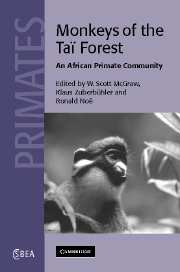Book contents
- Frontmatter
- Contents
- List of Contributors
- Preface
- 1 The monkeys of the Taï forest: an introduction
- Part I Social behavior
- 2 The social systems of the guenons
- 3 How small-scale differences in food competition lead to different social systems in three closely related sympatric colobines
- 4 The structure of social relationships among sooty mangabeys in Taï
- Part II Anti-predation strategies
- Part III Habitat use
- Part IV Conservation
- Appendix
- Index
- Plate section
- References
3 - How small-scale differences in food competition lead to different social systems in three closely related sympatric colobines
Published online by Cambridge University Press: 30 July 2009
- Frontmatter
- Contents
- List of Contributors
- Preface
- 1 The monkeys of the Taï forest: an introduction
- Part I Social behavior
- 2 The social systems of the guenons
- 3 How small-scale differences in food competition lead to different social systems in three closely related sympatric colobines
- 4 The structure of social relationships among sooty mangabeys in Taï
- Part II Anti-predation strategies
- Part III Habitat use
- Part IV Conservation
- Appendix
- Index
- Plate section
- References
Summary
Introduction
As an essential aspect of life, food can evoke strong competition among individuals and shape a species' social system. Through a pathway of relationships we can link the competitive regime that food evokes in a population to such seemingly loosely related traits as social relationships within and between groups, ranging patterns and dispersal patterns. Food most strongly determines female relationships in many mammals because female reproductive success is mainly constrained by food acquisition. Male success, on the other hand, largely depends on access to mating partners (Trivers 1972, Emlen & Oring 1977). The competitive regime among females can be predicted based on the contestability or usurpability of their food (Wrangham 1980, van Schaik & van Hooff 1983, van Schaik 1989, 1996, Isbell 1991, Sterck et al. 1997). In most primates, food competition increases with group size (Clutton-Brock & Harvey 1977, Wrangham et al. 1993). However, folivores do not always fit into the general patterns found in such studies (Clutton-Brock & Harvey 1977, Isbell 1991, Janson & Goldsmith 1995). A comparative test of the effect of diet on social systems within a largely folivorous genus can solve some of these controversies. Since dietary category is only a proxy for a whole suite of traits that together determines the contestability of a species' food we need to look at each of these traits to investigate differences within a dietary specialization.
Information
- Type
- Chapter
- Information
- Monkeys of the Taï ForestAn African Primate Community, pp. 72 - 108Publisher: Cambridge University PressPrint publication year: 2007
References
Accessibility standard: Unknown
Why this information is here
This section outlines the accessibility features of this content - including support for screen readers, full keyboard navigation and high-contrast display options. This may not be relevant for you.Accessibility Information
- 5
- Cited by
